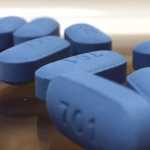The first once-daily single-tablet regimen containing an HIV protease inhibitor maintained viral suppression in 96 percent of people who switched from a multi-pill regimen after achieving an undetectable viral load, according to a report at the 9th International AIDS Society Conference on HIV Science (IAS 2017), held last month in Paris.
Most people starting HIV treatment for the first time can use regimens that consist of one pill taken once daily. But there are fewer single-tablet options for second-line therapy. Many previously treated people, especially those who have developed drug resistance, may need a protease inhibitor, as these drugs have potent and durable antiviral activity with a high barrier to resistance.
Jean-Michel Molina, MD, of the University of Paris, reported findings from the EMERALD study, a Phase III clinical trial evaluating a single-tablet regimen containing the protease inhibitor darunavir (sold separately as Prezista), cobicistat as a drug-level “booster,” and emtricitabine and tenofovir alafenamide or TAF (the drugs in Descovy).
This study included 1,141 participants in the United States and Europe. More than 80 percent were men, 75 percent were white and the median age was 46. The median CD4 count was approximately 630 cells per cubic millimeter, and they had normal kidney function at study entry.
Participants had to have a viral load below 50 copies per milliliter at for at least two months using a boosted protease inhibitor plus emtricitabine and tenofovir disoproxil fumarate (the drugs in Truvada). About 70 percent were on Prezista; most of the rest took Reyataz (atazanavir) or Kaletra (lopinavir/ritonavir). About 15 percent had a history of virological failure, but they could not have had a previous Prezista failure or resistance to this medication.
Study participants were randomly assigned to either receive the new darunavir single-tablet regimen for 48 weeks or remain on their current regimen.
Molina presented results from an interim analysis at week 24, showing that 96.3 percent of people who switched to the darunavir coformulation still had an undetectable viral load, as did 95.5 percent of those who stayed on their existing regimen. There were no cases of confirmed viral rebound above 200 copies/mL, and no one had to stop treatment because of virological failure.
Treatment was generally safe and well tolerated. There were few severe drug-related adverse events (1.2 percent in the single-tablet group and 0.5 percent in the continuation group), and only about 1 percent in both groups stopped treatment because of adverse events.
The researchers looked carefully at kidney and bone side effects, as TAF is easier on the kidneys and bones than the older version of tenofovir. A kidney function biomarker and hip and spine bone mineral density improved a bit in the single-tablet group while falling slightly in the continuation group, but these changes were small.
Based on these findings, the researchers concluded that the new combination pill “combines the safety advantages of TAF and darunavir with the known efficacy and high genetic barrier to resistance of darunavir in a single-tablet regimen.”
“I think it will improve the convenience of boosted protease inhibitor-based regimens, which require many pills today,” Molina said.







Comments
Comments